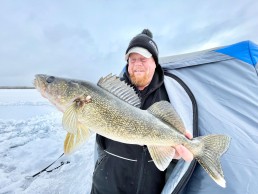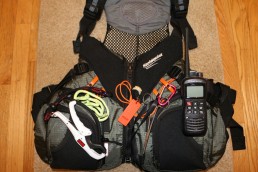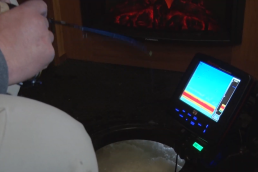Day Bites on the Ice
SHARE THIS POST
The early stages of ice have begun across the northern parts of the Ice Belt. While many large lakes need longer to freeze due to their size or deep water, shallow lakes are developing ice quickly due to the cooler water temperatures and lack of venting. Lakes such as Upper Red Lake and shallow sloughs in North and South Dakota have already developed a sheet of ice, and the ice thickens every night.
During this early season, ice fishing requires a little more work than midwinter, such as RAZRing holes, measuring and testing the ice all the way out to the desired spot. The reality is that if there is less than four inches of solid, clear ice, don’t go. Many resorts provide ice reports that detail ice thickness, foot travel and ATV travel funded by an access fee. If you are unsure about ice thickness, there are a wealth of ice fishing safety tips online.
Let it slide
Now that I’m hitting the ice, I never forget the most important tools of the journey. My Otter Utility Sled is loaded with ice tools of the trade:
• RAZR Synthetic Lite ice auger with a lithium drill and a few extra batteries in a bucket
• Humminbird Helix MEGA Live ice bundle with Lakemaster Maps on the GPS, facing forward towards me
• Otter Rod Case with a variety of St. Croix Custom Ice Rods
• A couple of boxes of perch/panfish jigs as well as walleye spoons, Northland Tungsten Flat Fry Jigs, Bro Bug Spoons and Mud Bugs, to name a few. For walleyes, Glass Buckshots, Puppet Minnows, Coffin Spoons, Flutter Spoons, a variety of different-sized Gamakatsu Octopus and walleye wide-gap live bait hooks and split shots.
• A couple spools of 4- to 7-pound Sunline Fluoro-Ice for leader material
• Two Otter Pro Jump seats to throw on top of the buckets when not kneeling on the ice
All this fits on the Otter Utility Sled and pulls with ease. It also easily loads and unloads from the truck bed. I pack an Otter Vortex Hub if it is cold and windy. When you have walkable ice, minimal gear keeps you mobile. I rarely wear more than a pair of bibs and my AFTCO Samurai hoodie and Fish Monkey Wooly gloves. It’s all I need to stay warm and sweat-free on the ice while hole hopping.
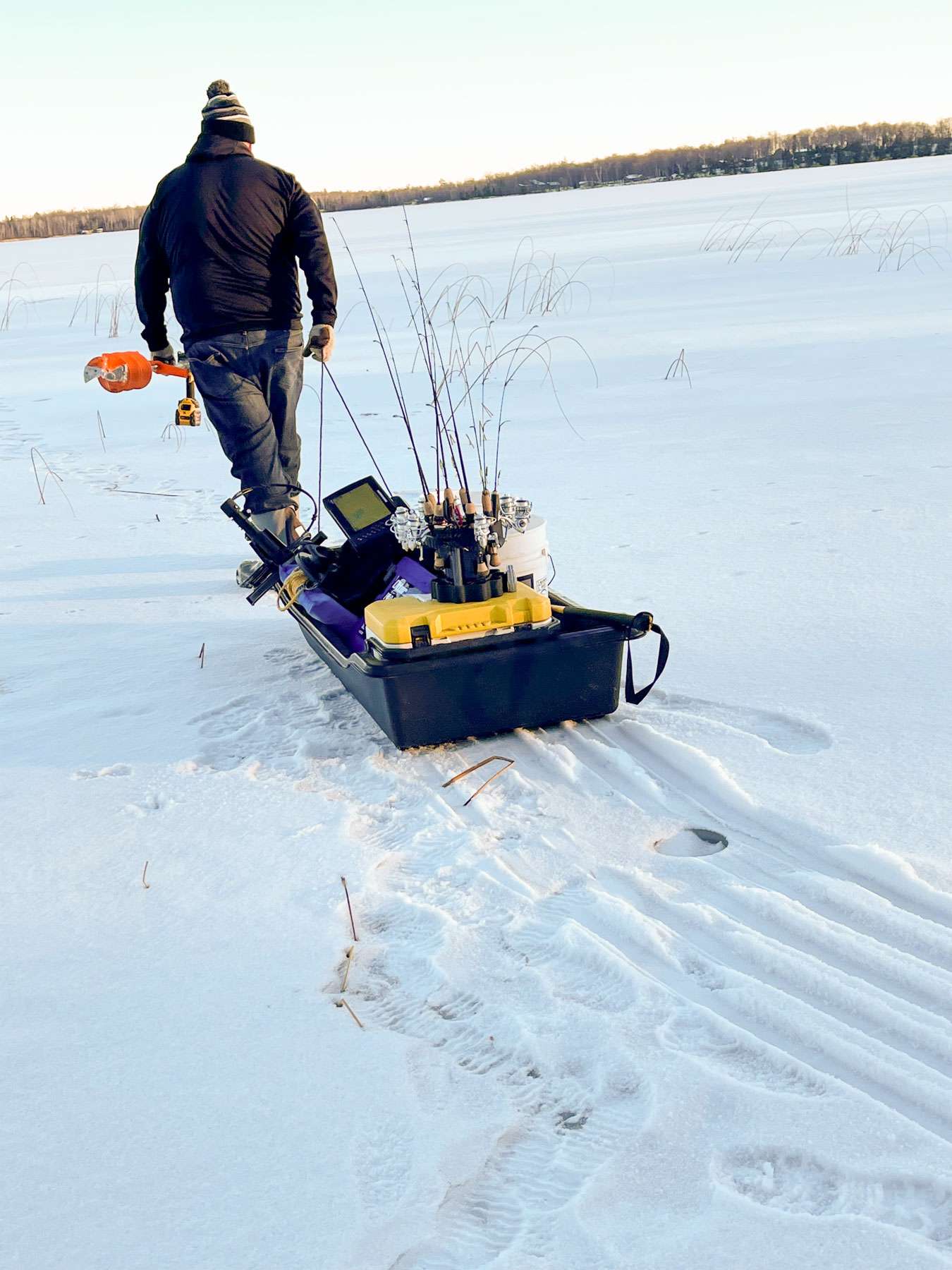
Day bite
As winter progresses, large lakes will be filled with wheelhouses and anglers camping overnight. Some will catch fish during the night, and a handful will catch lots of fish during the night. I have fished at night many times, but I prefer fishing during the day up until “the hour of power” at sunset.
There is a lot of fishing action to be had during the day on most lakes. There are bite windows where the fish get active and then shut off based on weather, barometer fluctuations and sun/moon phases. Water clarity is a given. Dark water is consistent during the daytime and there are large-lake destinations that are known to have bankers-hour walleye bites, such as Upper Red Lake and Lake of the Woods. Most of the lakes I fish have super-clear water, however.
If you are not seeing or catching fish during the open-water season when fishing in the boat, you move until you find them. On the ice, you RAZR holes until you locate fish. Today’s technology makes fishing easier in both fishing seasons.
Humminbird has a two-pronged approach for finding fish under the ice. MEGA 360 gives a photo-like image of the aquascape as well as fish shadows in a complete 360 degrees around you without moving the downrod. MEGA Live shows bottom solid objects and fish as they are swimming around you; turn the downrod with the supplied handle, and slowly scan in a circle until you spot fish.
I leave a distance chart on the screen. This gives me an immediate place to drill. You can set the distances you like to scan with forward-viewing in the menu screen. After you find the fish, drill your holes in a straight line and place the MEGA Live in down view to monitor multiple lines at the same time. This is perfect for anglers to share the same screen—either inside a house or outside—and see all their lines.
Are you enjoying this post?
You can be among the first to get the latest info on where to go, what to use and how to use it!
In the weeds
After locating a school of active walleyes or jumbo perch, you must make them bite. The challenge is figuring out the preferred color and jigging cadence. The fish give clues with follows or short bites, or by staying static and not moving at all. Weeds are a saving grace under the ice, just as they are in open water. Fish feel comfort and safety in the weeds and are more active at times. The only problem is that good vegetation dwindles from summer to winter as most of it dies off. There are always surviving weeds and some vegetation is stronger than others.
• Chara (aka sandgrass) would be my first choice. It is actually a form of algae that lines the hard-bottom areas on some lakes. It has no roots so it can get piled up in summer windstorms, giving it a pillow-like look with little clearings in between. This is a perfect place for perch and walleyes to conceal themselves as they hunt for minnows that hide in its skeletal body.
• Cabbage weeds seem to die; however, there are always a few areas that are green and healthy (or sometimes half dead) that hold fish.
• Eurasian watermilfoil degrades, but I have found lots of green in their weed beds, and every fish in the lake loves it, too.
Much of this depends on light penetration through the ice. Last winter, there was a lot less good vegetation than I have seen in previous years due to deep snow and slush.
If you search for fish around weed edges and clearings, you will bump up your success. Areas immediately outside of weeds, rock piles, logs, stumps and steep breaks will always hold fish in moderate depths from 8 to 25 feet. Walleyes and perch are creatures of edges.
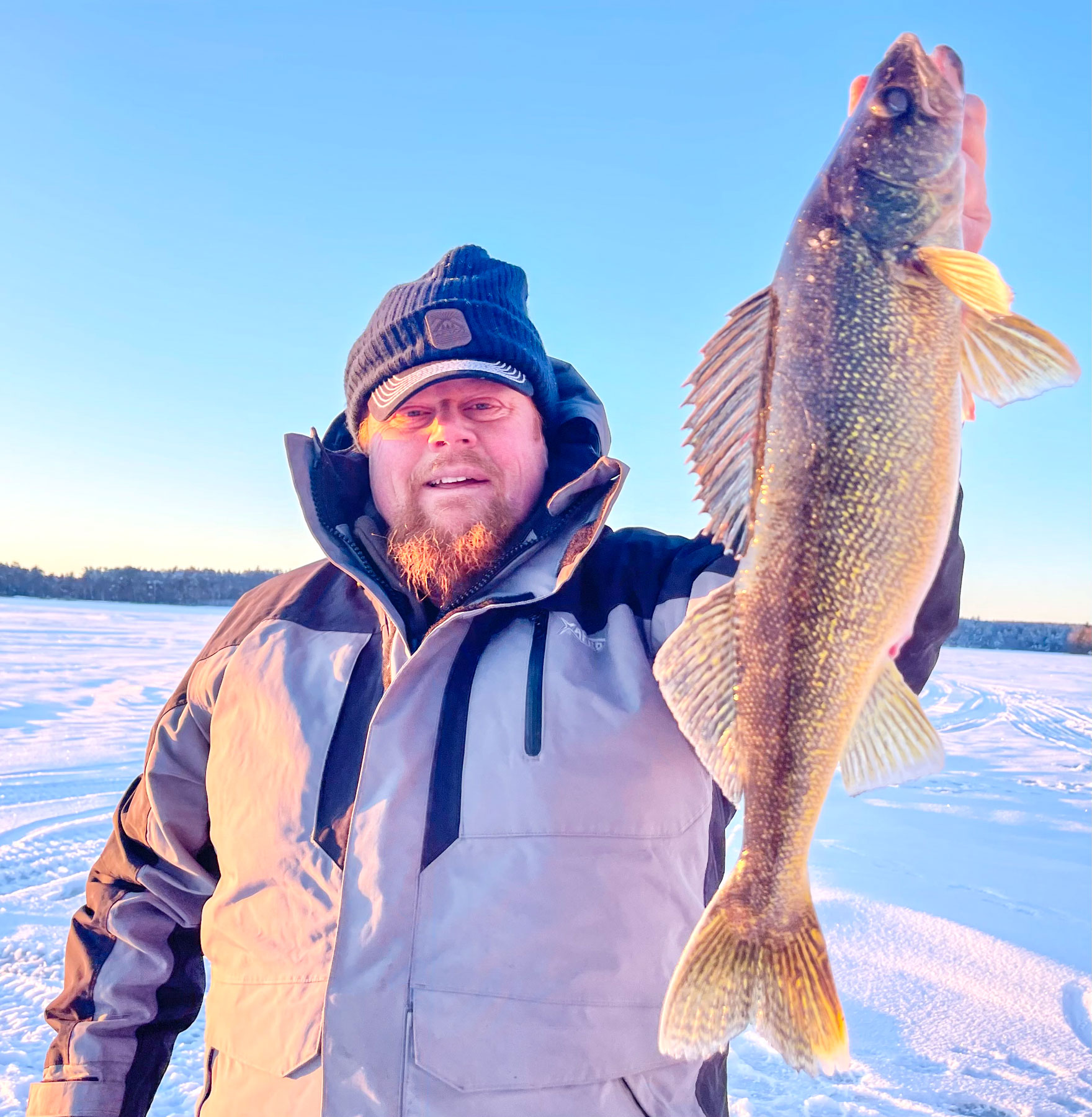
Seeing is believing
Some of my past experience fishing walleyes through the ice can be modified after applying what I learn from my Humminbird MEGA Live and 360 imaging. While fishing on the tops of lake humps and structures, I have seen fish off the structure, suspended over open water. I always knew they were out there, but an angler’s confidence goes up when you see them swimming by on your Humminbird. I sometimes find myself fishing off the edge of a steep hump, but not at the bottom of the basin; I am at the level of the structure’s top. Particularly when I have been fishing on the edge and found fish up on the top of the structure in 5 to 8 feet of water.
In the past, you couldn’t see fish as well, and it’s physically impossible to drill the entire lake out. Even if you found fish in the past by drilling many holes, you might not find them in the same spot the next year. Now you have the ability to watch fish movement where you are currently, as well as in the distance, at the same time.
Even if you walk softly and drill minimal holes, fish instinct is to move away from impending danger. Anglers are noticing that forward-viewing can be felt by fish, and it actually disturbs them enough to move away from the emitted beam. No worries! The Humminbird Helix ice bundle includes a second transducer with 2D sonar.
And if you’re wondering about power, I use Amped Outdoors lithium batteries in my Helix units, so I don’t run out of juice.
Flash, rattle or deadstick
Whether I am targeting walleyes or perch, I always start by dropping a Glass Buckshot or Coffin Spoon with a minnow head. If you are fishing open water, note where fish were located on your Humminbird screen. If they are swimming through 20 feet below the ice, I jig at 17 or 18 feet if they are active. If fish are swimming lethargically, I jig at 19 feet—just slightly above them to draw their attention.
Drop a Glass Buckshot and give it a two-foot sweep with your St. Croix rod, followed by some short jigging motions, and then a pause. Walleyes generally inspect the bait before they grab it. On top of the structures, pound the bottom and then rip it up, shaking the rattles of the Glass Buckshot. Lift up two feet and pause.
Meanwhile, I have a deadstick rod set 1 to 2 feet off the bottom. This is my St. Croix Custom Ice Dead Eye rod with 6-pound Sunline FC Ice, size 4 Gamakatsu Red octopus-style hook with a lightly dorsal-hooked rainbow or fathead, with a split shot above. I set it in an I Fish Pro tip-up; even from a distance, I know I have a bite when the flag goes up. I set I Fish Pro tip-ups 40 to 80 feet away from me to cover water. Setting your deadsticks in lightly drifted snow areas on clear ice will help you get more walleyes and jumbo perch bites on the ice.
MWO
SHARE THIS POST
Did you enjoy this post?
You can be among the first to get the latest info on where to go, what to use and how to use it!
Brian 'Bro' Brosdahl
Outdoor communicator Brian “Bro” Brosdahl lives in northern Minnesota. He is a walleye guide in the Cass Lake, Leech Lake and Lake Winnibigoshish areas. He is sponsored by Northland Fishing Tackle, Frabill/Plano, Aqua-Vu, Humminbird/Minn Kota, St. Croix Rods, Ranger Boats, and Evinrude. Guide inquiries: brosguideservice.com. Follow on social media.
